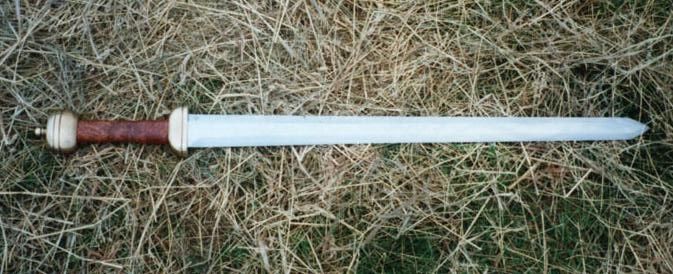Difference between revisions of "Steel spatha"
m |
m |
||
| Line 1: | Line 1: | ||
| − | Days needed :1<br> | + | [[Image:steel_spatha.jpg|frame|none|right|Image Source: [http://www.odinblades.com/Swords2k/SpathaX.jpg Odin Blades]]] |
| − | Raw materials needed: <br> | + | |
| − | Objects: [[steel spatha blade]] (1), [[medium wooden hilt]] (1) <br> | + | == Construction == |
| − | Tools needed: [[peen hammer]] | + | '''Days needed''' :1<br> |
| + | '''Raw materials needed:''' <br> | ||
| + | '''Objects:''' [[steel spatha blade]] (1), [[medium wooden hilt]] (1) <br> | ||
| + | '''Tools needed:''' [[peen hammer]] | ||
<br> [[Category:Weapons]] | <br> [[Category:Weapons]] | ||
| + | |||
| + | == OOC Info == | ||
| + | "The Spatha is a type of straight sword, measuring between 75 and 100 cm, in use throughout the 1st millennium AD. Introduced in the late Roman Empire in the 1st century AD as a cavalry weapon, the Spatha remained popular throughout the Migration period and the Viking Age, until it evolved into the knightly sword of the High Middle Ages from about 1100. Viking Age Spathas are also known as Viking swords. | ||
| + | |||
| + | Originally the Spatha was worn by cavalry officers and auxiliaries in the later Roman armies. Usually a longer version of the shorter, leaf-shaped gladius used by a legionary, the spatha is around 75 - 100 cm long but seldom reached a full metre. | ||
| + | |||
| + | Employed by both Roman cavalrymen and their German enemies, later Lombard spathae were actually more advanced than the wrought iron gladii, being constructed using a form of pattern welding employing layers of iron and steel: in effect, a composite material. Eventually under the later Roman Empire the Spatha was adopted by many if not most legionaries. | ||
| + | |||
| + | During the Viking age, the swords grew slightly in length to 37 in (930 mm) and took on a slightly more acute distal taper and point. These blades had deep fullers running their length, yet still had single handed hilts which often sported a 'brazil nut' shaped pommel. While the pattern of hilt and blade design of this time might readily be called 'The Viking sword' to do so would be to neglect the wide spread popularity it enjoyed. All over continental Europe between 700-1000 AD this design and its small variations could be found." - http://en.wikipedia.org/wiki/Spatha | ||
Revision as of 03:40, 8 October 2005

Construction
Days needed :1
Raw materials needed:
Objects: steel spatha blade (1), medium wooden hilt (1)
Tools needed: peen hammer
OOC Info
"The Spatha is a type of straight sword, measuring between 75 and 100 cm, in use throughout the 1st millennium AD. Introduced in the late Roman Empire in the 1st century AD as a cavalry weapon, the Spatha remained popular throughout the Migration period and the Viking Age, until it evolved into the knightly sword of the High Middle Ages from about 1100. Viking Age Spathas are also known as Viking swords.
Originally the Spatha was worn by cavalry officers and auxiliaries in the later Roman armies. Usually a longer version of the shorter, leaf-shaped gladius used by a legionary, the spatha is around 75 - 100 cm long but seldom reached a full metre.
Employed by both Roman cavalrymen and their German enemies, later Lombard spathae were actually more advanced than the wrought iron gladii, being constructed using a form of pattern welding employing layers of iron and steel: in effect, a composite material. Eventually under the later Roman Empire the Spatha was adopted by many if not most legionaries.
During the Viking age, the swords grew slightly in length to 37 in (930 mm) and took on a slightly more acute distal taper and point. These blades had deep fullers running their length, yet still had single handed hilts which often sported a 'brazil nut' shaped pommel. While the pattern of hilt and blade design of this time might readily be called 'The Viking sword' to do so would be to neglect the wide spread popularity it enjoyed. All over continental Europe between 700-1000 AD this design and its small variations could be found." - http://en.wikipedia.org/wiki/Spatha